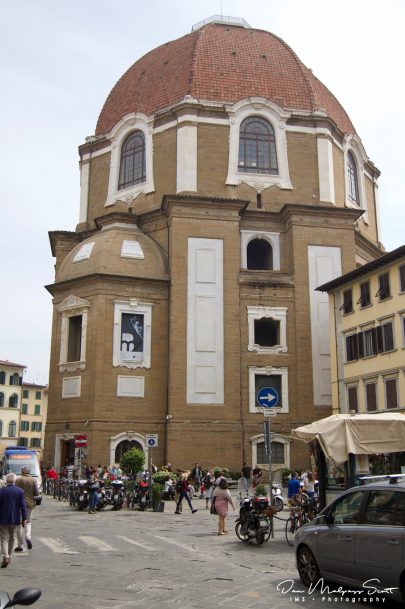The Medici Chapels (Cappelle medicee) are two structures at the Basilica of San Lorenzo, Florence, Italy, dating from the 16th and 17th centuries, and built as extensions to Brunelleschi’s 15th-century church, with the purpose of celebrating the Medici family, patrons of the church and Grand Dukes of Tuscany. The Sagrestia Nuova, (“New Sacristy”), was designed by Michelangelo. The larger Cappella dei Principi, (“Chapel of the Princes”), though proposed in the 16th century, was not begun until the early 17th century, its design being a collaboration between the family and architects.
Cappella dei Principi
The octagonal Cappella dei Principi surmounted by a tall dome, 59 m. high, is the distinguishing feature of San Lorenzo when seen from a distance. It is on the same axis as the nave and chancel to which it provides the equivalent of an apsidal chapel. Its entrance is from the exterior, in Piazza Madonna degli Aldobrandini, and through the low vaulted crypt planned by Bernardo Buontalenti before plans for the chapel above were made.
The opulent Cappella dei Principi, an idea formulated by Cosimo I, was put into effect by Ferdinand I de’ Medici. It was designed by Matteo Nigetti, following some sketches tendered to an informal competition of 1602 by Don Giovanni de’ Medici, the natural son of Cosimo I, Grand Duke of Tuscany, which were altered in the execution by the aged Buontalenti. A true expression of court art, it was the result of collaboration among designers and patrons.
For the execution of its astonishing revetment of marbles inlaid with colored marbles and semi-precious stone, the Grand Ducal hardstone workshop, the Opificio delle Pietre Dure was established. The art of commessi, as it was called in Florence, assembled jig-sawn fragments of specimen stones to form the designs of the revetment that entirely cover the walls. The result was disapproved of by 18th and 19th century visitors, but has come to be appreciated for an example of the taste of its time. Six grand sarcophagi are empty; the Medici remains are interred in the crypt below. In sixteen compartments of the dado are coats-of-arms of Tuscan cities under Medici control. In the niches that were intended to hold portrait sculptures of Medici, two (Ferdinando I and Cosimo II) were executed by Pietro Tacca (1626–42).
The Lantern
The lantern at the top of the Medici Chapel is made out of marble and has an “….unusual polyhedron mounted on the peak of the conical roof,”. The orb that is on top of the lantern has seventy-two facets and is about two feet in diameter. The orb and cross, that is on top of the orb, are traditional symbols of the Roman and Christian power, and recalls the similar orbs on central dome plan churches like St. Maria del Fiore and St. Peter’s. But because it is on a private mausoleum, the Medici family is promoting their own personal power with the orb and cross, laurel wreath and lion heads, which are all symbols of status and power.
The lantern that holds up the orb helps to accentuate the height and size of the chapel, which is fairly small. The lantern is a bit less than seven meters tall and, “…is equal to the height of the dome it surmounts,”. The lantern metaphorically expresses the themes of death and resurrection. The lantern is where the soul could escape and go from “…death to the afterlife.”.


